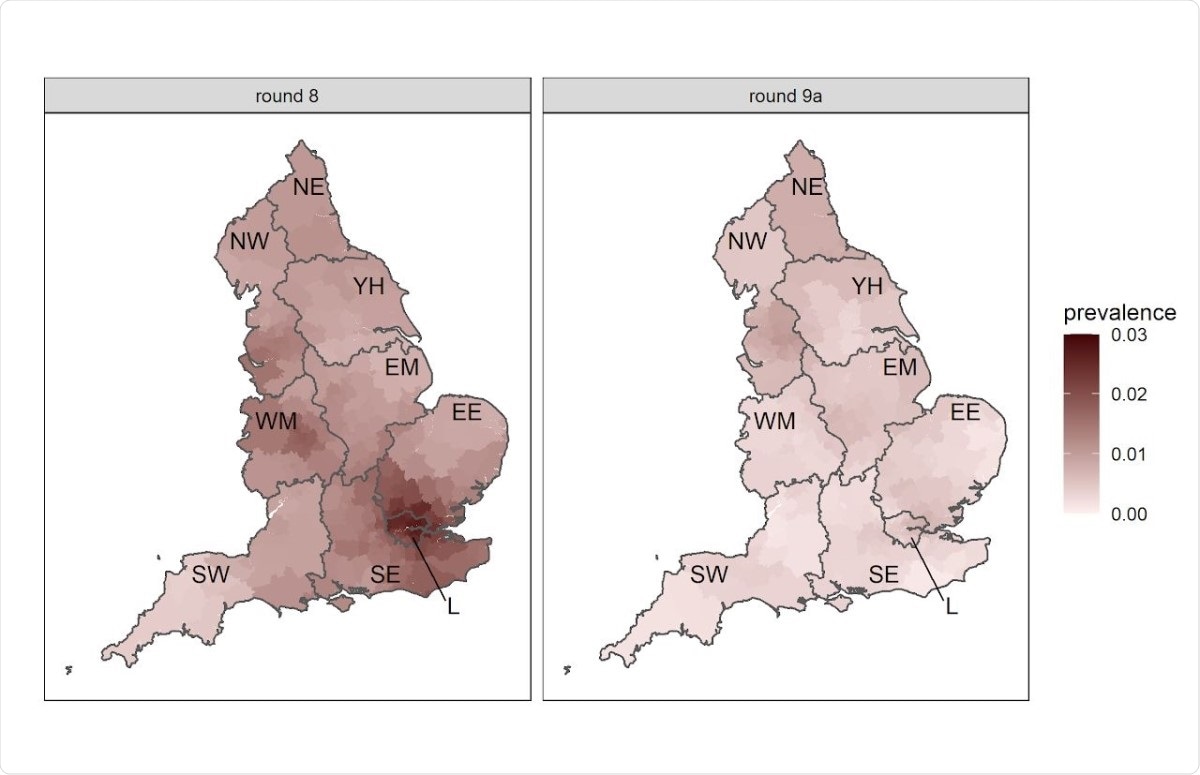Results from the latest round of the real-time assessment of community transmission study (REACT-1) study in England indicate that although coronavirus disease 2019 (COVID-19) cases have decreased, the number of hospitalizations remains high.
Since the beginning of the COVID-19 pandemic early in 2020, there have been several waves of infection. In England, the second wave of infections began in September 2020. With strict social distancing, the number of cases declined, and as the social distancing norms were relaxed, the cases increased.
Beginning December 2020, the number of infections increased significantly, with regions in the South being affected more than those in the North. The increase in cases was attributed to the new variant of the severe acute respiratory syndrome coronavirus 2 (SARS-CoV-2), the causative agent of COVID-19, that emerged around September 2020. A third lockdown was imposed beginning January 2021 to break the transmission chain.

 *Important notice: medRxiv publishes preliminary scientific reports that are not peer-reviewed and, therefore, should not be regarded as conclusive, guide clinical practice/health-related behavior, or treated as established information.
*Important notice: medRxiv publishes preliminary scientific reports that are not peer-reviewed and, therefore, should not be regarded as conclusive, guide clinical practice/health-related behavior, or treated as established information.
To determine patterns of prevalence of COVID-19, throat and nose swabs are obtained randomly in the England population as part of the REACT-1 study program. Round 8 of the study collected samples between 6 and 22 January 2021. The results showed an increase in the number of cases for the first ten days and then a decrease over the next seven days.
Decline in cases during third lockdown
In a paper published in the medRxiv* preprint server, researchers report the results of round 9a of REACT-1 for self-administered swabs that were collected between 4 and 13 February 2021.
The first round of REACT-1 began in May 2020, and since then, around 150,000 to 175,000 people above the age of five provided throat and nose swabs for real-time polymerase chain reaction reverse transcription (RT-PCR) testing.
Data is usually collected every 2-3 weeks at monthly intervals. An online or telephone survey is used to collect demographics, symptoms, and lifestyle. The results are analyzed to provide unweighted and weighted SARS-CoV-2 infection estimates, to account for sampling method and differential response.
In round 9a, there were 378 positive samples out of 85,473 swabs, giving a weighted prevalence of 0.51%. This is a more than a two-thirds decrease in the positive cases from 1.57% in the previous round. Upon further analysis, the researchers found a halving time of 14.6 days in the latter half of round 8 and in round 9a. When analyzed for the entire round 8 and round 9a, the halving time was 20.4 days.
From round 8 to round 9a, there was a decline in weighted regional prevalence. The greatest declines were in London, West and East Midlands, and East and Southeast England. The highest cases were now in the North. The reproduction number was less than one everywhere except for North East, North West, Yorkshire and The Humber.

Neighborhood prevalence of swab-positivity for rounds 8 and 9a. Neighborhood prevalence calculated from nearest neighbors (the median number of neighbors within 30km in the study). Average neighborhood prevalence displayed for individual lower-tier local authorities. Regions: NE = North East, NW = North West, YH = Yorkshire and The Humber, EM = East Midlands, WM = West Midlands, EE = East of England, L = London, SE = South East, SW = South West.
Cases also declined among all age groups. The highest prevalence was in the 18 to 24 years olds and 5 to 12-year-olds. The lowest prevalence was in people older than 65 years.
Continued monitoring still needed
The results of REACT 9a, which started about a month after the third lockdown, indicate a sharp decline in SARS-CoV-2 prevalence. This decline follows a plateau in the prevalence at the beginning of the lockdown and going down thereafter. The trend is similar to the trend from testing symptomatic patients.
The prevalence in London was about 3%, and about 4% for young people and the prevalence dropped by 80% in London, South East, and West Midlands.
The United Kingdom started vaccination for COVID-19 in December 2020, with the vaccine being offered to almost everyone older than 70 years. However, the prevalence of COVID-19 for those above 65 years is similar to that in other age groups. This suggests the decrease is mainly due to reduced social interactions rather than the effect of vaccination.
The prevalence was higher in people of Asian origin compared to white and more cases were seen in people living in the most deprived areas. Hospital and home care workers had higher prevalence suggesting this group has ongoing infection risk.
The authors note several limitations of the study. Despite correcting for sampling, the sampled population may not be truly representative of the true population. But, the study does not have self-reporting bias, arising from only testing symptomatic patients. The self-administered swabs may be less reliable than those taken by health care professionals, although detailed video instructions are provided.
Thus, although there is a significant decrease in COVID-19 prevalence in England during January and February 2021, the prevalence is still high. The number of hospitalizations is higher than that in the first wave of the pandemic.
The effects of easing of social distancing when we transition out of lockdown need to be closely monitored to avoid a resurgence in infections and renewed pressure on health services,” the authors write.

 *Important notice: medRxiv publishes preliminary scientific reports that are not peer-reviewed and, therefore, should not be regarded as conclusive, guide clinical practice/health-related behavior, or treated as established information.
*Important notice: medRxiv publishes preliminary scientific reports that are not peer-reviewed and, therefore, should not be regarded as conclusive, guide clinical practice/health-related behavior, or treated as established information.